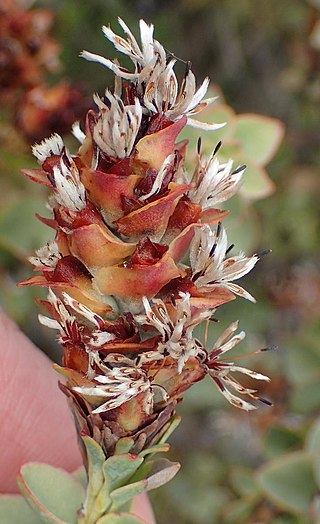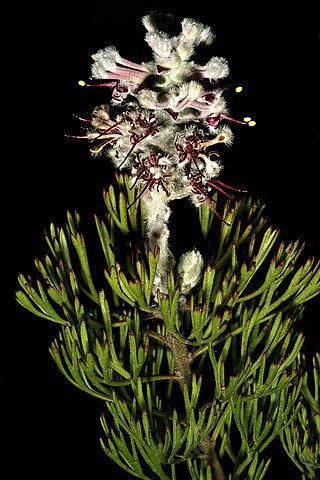
Leucadendron procerum, the ivory conebush, is a flower-bearing shrub that belongs to the genus Leucadendron and forms part of the fynbos. The plant is native to the Western Cape, South Africa.

Leucadendron rubrum, the spinning top, is a flower-bearing shrub belonging to the genus Leucadendron and forms part of the fynbos. The plant is native to the Western Cape, South Africa.

Leucadendron teretifolium, the needle-leaf conebush, is a flower-bearing shrub belonging to the genus Leucadendron and forms part of the fynbos. The plant is native to the Western Cape, South Africa.
Leucadendron osbornei, the Laingsburg conebush, is a flower-bearing shrub belonging to the genus Leucadendron and forms part of the fynbos. The plant was discovered by David Osborne and is native to the Western Cape, South Africa.
Paranomus adiantifolius, the hairy-style sceptre, is a flower-bearing shrub that belongs to the genus Paranomus and forms part of the fynbos. The plant is native to the Western Cape, South Africa.

Paranomus sceptrum-gustavianus, the King Gustav's sceptre, is a flowering shrub that belongs to the genus Paranomus and forms part of the fynbos. The plant is native to the Western Cape, South Africa.

Paranomus dregei, the scented sceptre, is a flowering shrub belonging to the genus Paranomus. The plant is native to the Western Cape, South Africa.

Paranomus longicaulis, commonly known as exploding baked apple and woolly sceptre, is a flower-bearing shrub that belongs to the genus Paranomus and forms part of the fynbos. The plant is native to the Western Cape where it occurs on the eastern Langeberg from Garcia Pass to the Attakwaskloof.

Paranomus roodebergensis, also known as the honey-scented sceptre, is a flower-bearing shrub that belongs to the genus Paranomus and forms part of the fynbos. The plant is native to the Western Cape, South Africa.

Paranomus spathulatus, the Langeberg sceptre, is a flower-bearing shrub that belongs to the genus Paranomus and forms part of the fynbos. The plant is native to the Western Cape, South Africa.

Paranomus bolusii, the Overberg sceptre or viking sceptre, is a flower-bearing shrub that belongs to the genus Paranomus and forms part of the fynbos. The plant is native to the Western Cape, South Africa.

Paranomus centaureoides, the Ladismith sceptre, is a flower-bearing shrub that belongs to the genus Paranomus and forms part of the fynbos. The plant is native to the Western Cape, South Africa.
Paranomus candicans, the powder sceptre, is a flower-bearing shrub that belongs to the genus Paranomus and forms part of the fynbos. The plant is native to the Western Cape, South Africa.
Paranomus lagopus, the rabbit-paw sceptre, is a flower-bearing shrub that belongs to the genus Paranomus and forms part of the fynbos. The plant is native to the Western Cape where it occurs in the Koue Bokkeveld Mountains, Groot-Winterhoek Mountains and Elandskloof Mountain.
Paranomus reflexus, the Van Staden's scepter, is a flower-bearing shrub that belongs to the genus Paranomus and forms part of the fynbos. The plant is native to the Eastern Cape where it occurs on the Elandsberg and Van Stadensberg.
Paranomus capitatus, the fine-leaf sceptre, is a flower-bearing shrub that belongs to the genus Paranomus and forms part of the fynbos. The plant is native to the Western Cape where it occurs in the Du Toits Mountains south of Du Toitskloof Pass to the northern slopes of the Riviersonderend Mountains.

Paranomus dispersus, the long-head sceptre, is a flower-bearing shrub that belongs to the genus Paranomus and forms part of the fynbos. The plant is native to the Western Cape, South Africa.
Paranomus esterhuyseniae, the Kouga sceptre, is a flower-bearing shrub that belongs to the genus Paranomus and forms part of the fynbos. The plant is native to the Western Cape where it occurs in the Kouga Mountains and Outeniqua Mountains.

Paranomus tomentosus, the hairy-leaf tree sceptre, is a flower-bearing shrub that belongs to the genus Paranomus and forms part of the fynbos. The plant is native to the Western Cape, South Africa.
Paranomus spicatus, the Kogelberg sceptre, is a flower-bearing shrub that belongs to the genus Paranomus and forms part of the fynbos. The plant is native to the Western Cape where it occurs in the Hottentots Holland Mountains from Sir Lowry's Pass to Kogelberg.

























